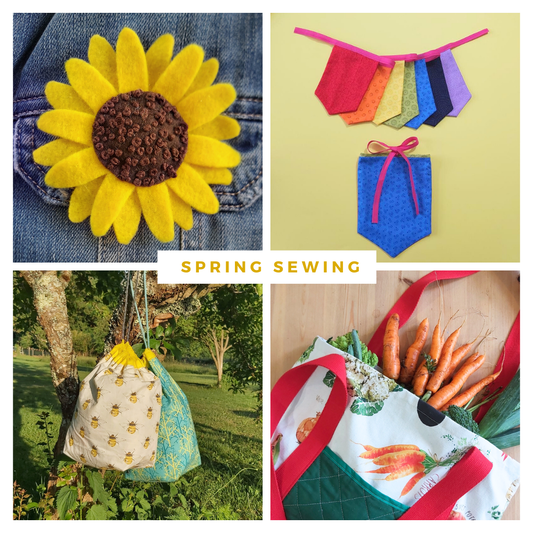Making good choices when it comes to the environment and the health of future generations is something we all want to do, right?!
One way to do this is by choosing sustainable fabrics that are kind to the environment during the manufacturing process, kind to the people making them and kind to the planet by producing less waste.

So firstly what are sustainable fabrics?
Fabrics are considered sustainable if they are made from natural or recycled materials to reduce harmful environmental impact in the making processes. And these type of fabrics can often require smaller amounts of water, soil and pesticides to be grown.
Choosing sustainable fabrics offers several BENEFITS for both the environment and the consumers like us.
Here are some reasons why you might consider opting for a sustainable fabric for your next purchase.
Reduced Water Usage: Sustainable fabrics often require less water during cultivation and production compared to conventional materials.
Lower Carbon Footprint: Sustainable fabrics are typically produced using eco-friendly processes, resulting in lower greenhouse gas emissions.
Biodegradability: Many sustainable fabrics are biodegradable, meaning they break down naturally without causing harm to any ecosystem.
Ethical Labor Practices: Sustainable fabrics are often associated with fair labour practices. Choosing these materials supports workers’ rights and ensures better working conditions in the textile industry.Durability and Longevity: Sustainable fabrics are designed to be durable and long-lasting. Investing in quality materials means your clothing will withstand wear and tear, reducing the need for frequent replacements.
Cost-Effectiveness: While sustainable fabrics may have a slightly higher upfront cost, their longevity and durability make them cost-effective in the long run.
WOW there's food for thought there isn't there?!
So which fabrics are sustainable and which are not?
Here are 5 sustainable/eco fabrics to look out for:
Hemp
Hemp is one of the most sustainable crops on the planet, requiring little water and no harmful pesticides or herbicides. It’s also a fast-growing crop, which means it can be harvested more frequently than other crops.

Hemp fabric is durable, strong and has a longer lifespan than other fabrics because it can withstand frequent washing and wear without losing its integrity making it a fabulous choice.
LINEN
Linen is made from the flax plant, a versatile crop in which all of its parts can be used. It doesn’t need a lot of water or pesticides, and overall linen is a great fabric to sew with. Linen is biodegradable, so after it's long life it will gently decompose without leaving any waste. And even better all parts of the flax plant can be used, meaning there are no harmful bi-products as a result of the manufacturing process.

Linen is easy to mark, sew, and press, as well as being a joy to wear thanks to its breathable and cooling properties. It’s an absolute must to pre-wash your linen by otherwise it will shrink. Linen is also prone to fraying because of its open weave, so take care to finish your seams and edges properly.
TENCEL
Tencel is a brand name for a set of fibres called lyocell and Model. Lyocell is a form of regenerated cellulose derived from wood pulp from certified sustainable forests. It is eco because it's production does not use carbon disulfide, which is toxic to workers and the environment.

Described as Vegan silk Tencel is naturally breathable, so air can flow in and out of the material and prevent heat retention. It wicks away moisture and dries quickly and apparently does not get attacked by moths. This fabric creases less and is easier to iron as compared to cotton fabrics.
BAMBOO
Bamboo is incredibly easy to grow; it matures very quickly, and it can grow in areas that are not suitable for other crops. Therefore, the environmental impact of cultivating bamboo is relatively minimal in theory, and it's up to individual bamboo cultivators to ensure that their crop is obtained in a sustainable manner so do your research and find out where the fabric is coming from.

True Bamboo fabric, made with mechanical eco processes, is very strong, durable, and soft with added antibacterial properties. This fabric is highly breathable, and it is also more stretchy than cotton so a great choice for under garments and base layers.
ORGANIC COTTON
Organic cotton is grown without the use of synthetic fertilizers and pesticides and produces a significantly lower environmental impact than traditional cotton using a lot less water in the manufacturing process. While organic cotton still has an impact, it is a much more eco-friendly choice than traditional cotton.

Organic cotton has a soft feel and drape, suited to a huge range of uses and projects. But be mindful of shrinkage as traditional cotton is generally treated with chemicals to reduce the shrinkage effects of heat so wash low and air dry.
Fabrics to stay away from where possible:
- Viscose rayon
- Polyester
- Acrylic
- Nylon
These fabrics are most harmful to the environment because they either produce plastic pollution on a massive scale or are manufactured through hazardous chemically intensive processes.

If you are wondering where to buy eco fabrics, I'll be doing some research and looking for my favourites highstreet and online stores so look out for future BLOG posts.
Don't forget that not all fabrics have to be new, you may find good fabric supplies in your local thrift/charity shop because reusing will always be the best choice to avoid waste.
If your interested in more ways to be eco in your sewing I have lots of ideas saved on a PINTEREST board HERE
I do hope that you found this information helpful and that you will be able to use this knowledge to help you make eco choices in your sewing practice.
If you find good places to buy truly eco fabrics please drop a comment below and share the love so we can all take a look.
Until next time, Happy Sewing




